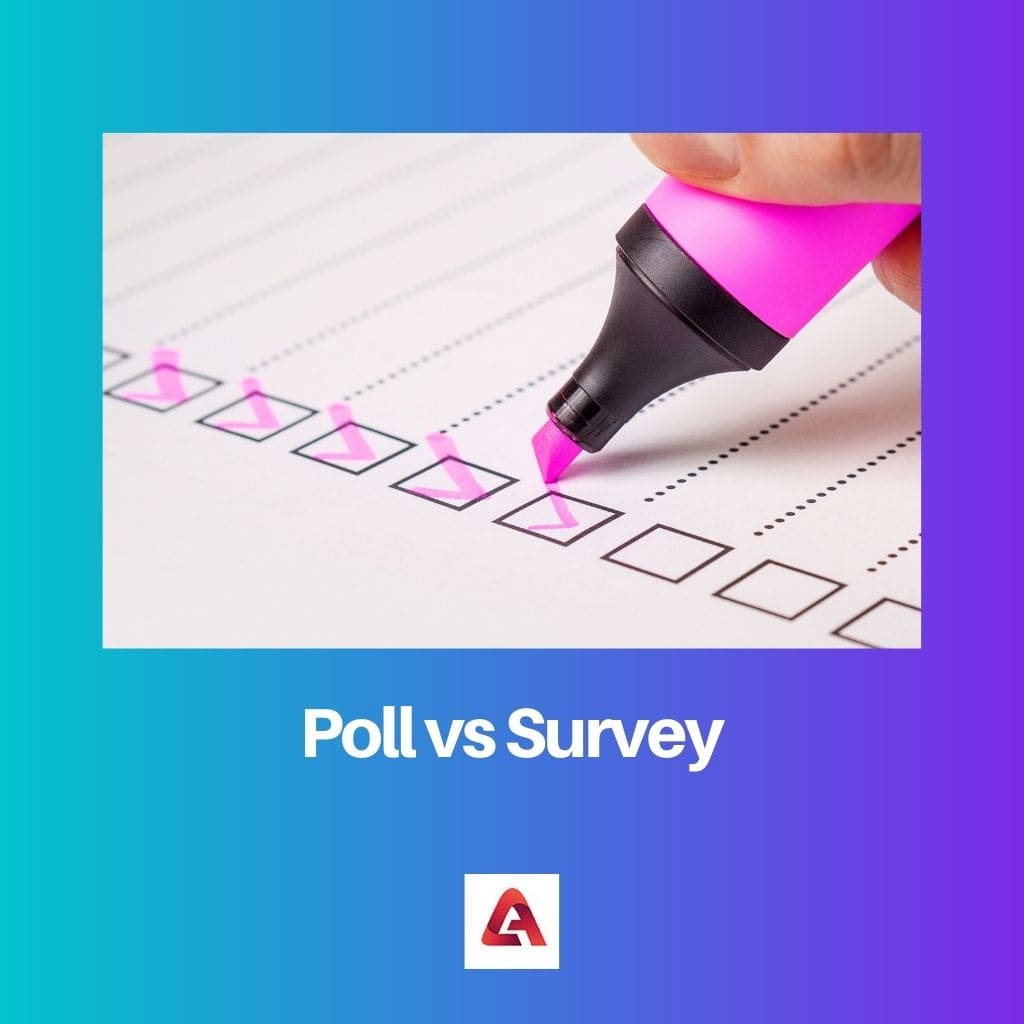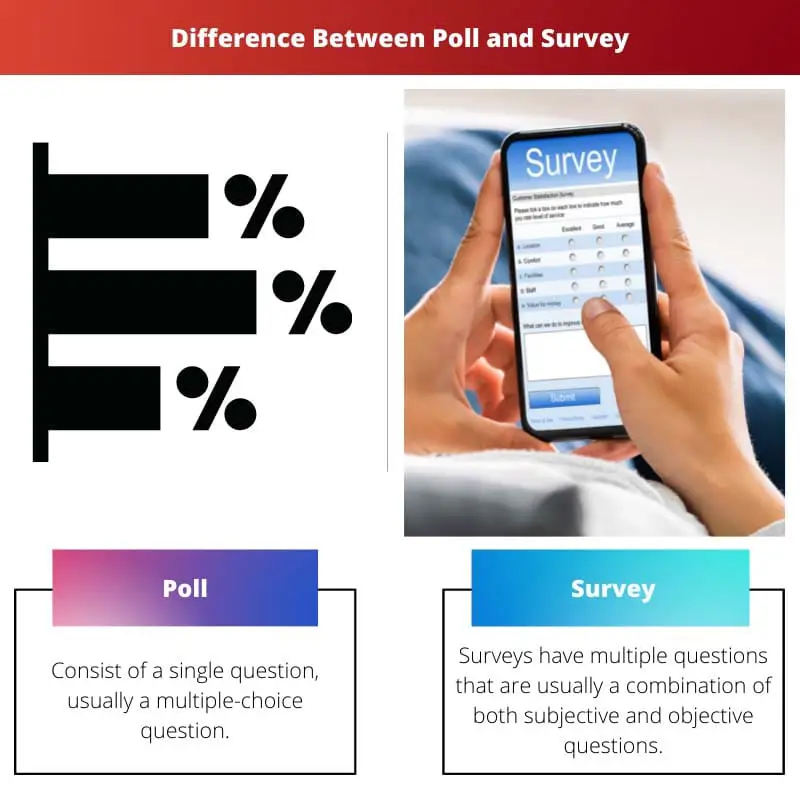There are several methods of data collection in research. Research plays a vital role in the market and academia. There are different types of data processing systems for various kinds of data.
The data collection method can be picked depending on the nature of the data (quantitative or qualitative), sample size, and other factors.
Among the various categories of data collection, polls and surveys are the most frequently used methods in market research. They offer easy analysis and operation options.
Key Takeaways
- A poll is a type of survey that gathers opinions or preferences from a sample of respondents by asking one or more specific questions. In contrast, a survey is a broader research method that collects data from a sample of individuals through a series of questions or statements.
- Polls are used to gauge public opinion on a particular topic or issue quickly. At the same time, surveys can cover a wide range of topics and provide more in-depth information about respondents’ opinions, experiences, or behaviors.
- Both polls and surveys are valuable tools for gathering information and understanding different populations, but their scope and purposes can vary significantly.
Poll vs. Survey
The difference between a poll and a survey is that a poll is one single multiple-choice question, while a survey includes multiple questions that can be objective and subjective.

Comparison Table
| Parameter of Comparison | Poll | Survey |
|---|---|---|
| Questions | Consist of a single question, a multiple-choice question | Surveys have multiple questions that are a combination of both subjective and objective questions. |
| Time | Since it’s just one question, it does not take much time | The time taken by respondents to fill up a survey may vary depending upon the number of questions. They are more elaborate. |
| Information | Respondents are rarely asked to give out their details. | Surveys require details of the respondents to know more about the data that has been collected. |
| Purpose | To get an overview of what people take from an event or an experience. | To understand in-depth things such as customer satisfaction, feedback, etc. |
| Type of decision | Polls are simple, unidimensional decisions | Surveys require feedback on multiple dimensions. |
What is Poll?
A poll is a question asked from s set sample size to know people’s preferred options.
The questions asked in a poll can be both multiple-choice and open-ended. It is a system to know and understand people’s choices.
The methodology of conducting polls has evolved significantly over time. Initially, poles were conducted in person, where people were asked questions, and responses were recorded on the show of hands.
Later telephonic polls and polls via SMS became very common.
In the current times, however, polls are done online. Respondents can submit their answers with a single click. Online polls allow the poll designer to design the vote per their requirements.
Companies extensively use polls to understand what their customers want. A company that knows the likes and dislikes of its customers can surely do better.
Since a poll is just one question, it can provide limited insight, so votes must be used judiciously.
Polls have a considerable sample size. It gives a comparative overview of the choices of the population in question.
Since the outcome data of polls is not elaborate, the processing and analysis that can be done through this data are also limited.
A prevalent form of Poll is the election poll. Such polls are used to understand which political party or candidate is more popular or are likely to win in the elections.

What is Survey?
The survey data collection method is done to generalize the results over a relatively more significant population.
Data collected using the survey method is critical in business and academic research.
It is a more elaborate data collection form, providing detailed insights and information. A survey has more than one question, which can be subjective and objective.
Surveys can be divided into four categories depending on the methodology adopted. They can be face-to-face, telephonic, self-administered, or online.
This method has been recognized as an ideal method for in-depth data collection.
Online surveys have made pen-and-paper surveys obsolete since the cost of administering an online survey is way less.
The critical rule while using a survey is to design it correctly. A survey must ask the right questions in the correct format. One must ensure that redundancy is eliminated.
Additionally, a survey must be distributed through the proper channels to ensure that the right kind of responses is recorded.
Surveys are extensively used to collect customer feedback about events and products.
Since surveys are longer, convincing customers to fill out such forms isn’t easy. It is essential to design a relatively short survey. Some companies offer incentives for filling out survey forms.

Main Differences Between Poll and Survey
- A poll is a question circulated to understand people’s relative preferences, while a survey is an elaborate data collection method with multiple queries.
- Naturally, the time to fill out a poll is less than a survey.
- Polls record responses; however, the respondent’s personal information is rarely required. Whereas surveys require the intimate knowledge of the respondent.
- A poll focuses on understanding the sample’s relative preference, while a survey focuses on multiple dimensions.
- Responses to a poll are based on simple and quick decisions, while a survey requires in-depth analysis.

- https://www.jstor.org/stable/2747357
- https://academic.oup.com/alcalc/article-abstract/39/6/532/211277

The article does an impressive job of explaining the need for surveys and how they are conducted, making it an essential read for anyone interested in research methodologies.
Yes, the depth of information about the significance and uses of surveys is quite engaging and thought-provoking.
Absolutely! The discussions on the importance and conduct of surveys are very intellectual and will be helpful for those engaging in market and academic research.
I particularly appreciate the detailed explanations of what polls and surveys are and how they are conducted. Very informative and useful content.
Right! The section about online polls and the evolution of different survey types is particularly enlightening.
I appreciate how it is explained that the methodology of conducting polls has evolved over time and how surveys have changed the way data is collected. This is an enlightening content.
Absolutely. The content is rich in information and knowledge about the evolution of polls and surveys. Very insightful.
I find how the article explains the uses and design requirements of surveys and polls particularly insightful and helpful. Great analytical content.
Absolutely, the article is comprehensive and provides detailed insights into the purposes and design of surveys and polls, making it a great learning resource.
The section about customer feedback and the significance of understanding customer preferences is enlightening. This content is indeed very informative.
This article amicably raises its insightful tone by classifying the different types of surveys and their significance. It explains why surveys have become a popular data collection tool.
I especially appreciate the detailed insights and division of surveys into face-to-face, telephonic, self-administered, and online categories. The article is very comprehensive.
Agree with that! The section about the methodology of surveys, especially how online surveys have revolutionized the process, is very relevant and interesting.
The comparison table is very effective in understanding the key differences between polls and surveys. This article is an essential read for anyone looking to gain knowledge in data collection methods.
Absolutely. The comparison table is a great addition, adding clarity to the distinction between polls and surveys.
The detailed explanation about the evolution of polls from in-person to online, and the different types of survey methodologies, is presented in an engaging and informative manner. Great article!
I agree! The depth of information about the evolution and methodologies of polls and surveys is very intellectually stimulating.
The detailed information provided differentiating polls and surveys is highly commendable. The analysis provided is quite accurate and insightful.
Absolutely! The article does an excellent job of clearly explaining the purpose and types of polls and surveys, making it very understandable.
Indeed! The content is definitely informative and highlights the unique aspects and significance of both polls and surveys.
The accuracy with which the article explains polls and surveys is highly commendable. The information is comprehensive and well-presented.
Agreed! The detailed insights into the significance of polls and surveys make this article an impressive read for those interested in research methodologies.
I particularly enjoyed the sections about the different types of surveys and their uses. It is very informative and enriching content.
This article does a great job of differentiating between data collection methods and the different kinds of surveys and polls. It’s very informative and succinct.
Yes! It’s particularly useful and accurate to point out the difference between a survey and a poll, as well as explaining the purposes of each.